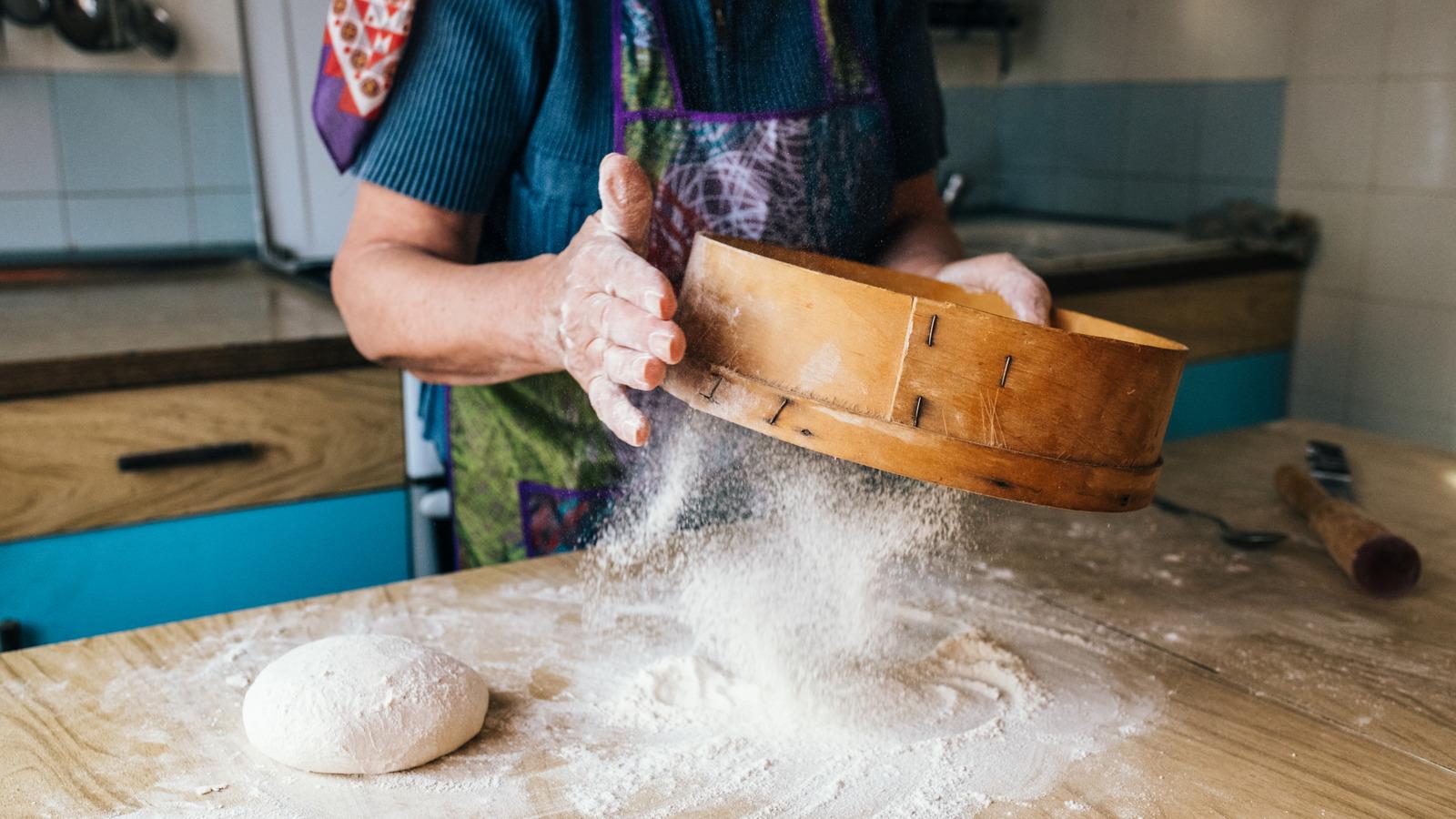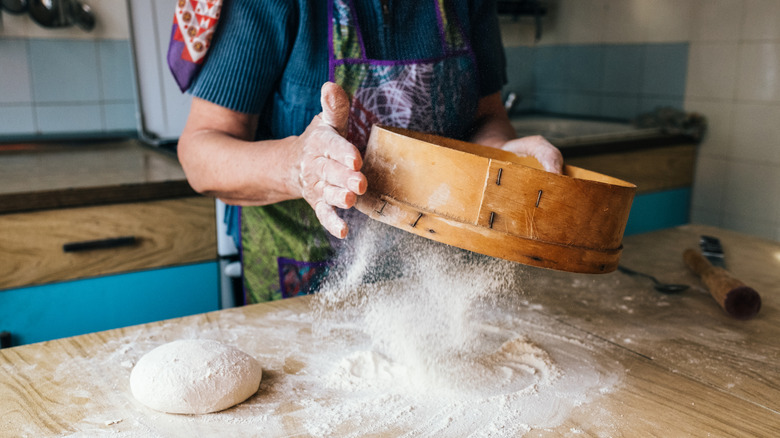
Photoguns/Getty Images
If you dig around in a vintage market or antiques store, you're likely to find some old-fashioned baking tools collecting dust. These are tools you might have seen in your kitchen growing up, or maybe your grandmother used them. Some of them might even be kitchen tools you've never seen before. Or if you have seen them, it's because they're being displayed as decoration instead of being actively used to make pies, cookies, and cakes. At one time, though, these old-school baking tools were cutting-edge aids used by home bakers everywhere.
Modern baking tools are still manufactured to make baking more convenient for home cooks. These tools are easy to use, easy to clean, and prepare ingredients faster than many old-school tools. If you're a home baker, you probably appreciate that convenience and use it as much as possible. But even though these old-school baking tools have mostly vanished from our kitchens, they still deserve recognition for how they made baking and other kitchen work easier once upon a time.
Pastry blender
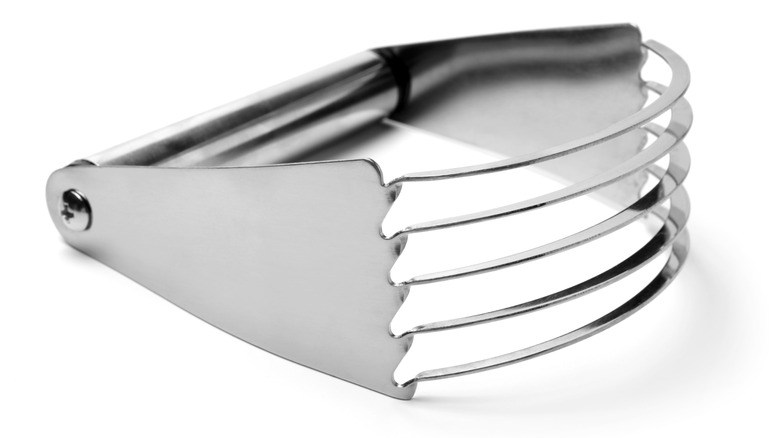
Popovaphoto/Getty Images
Today, many home bakers make an easy pie crust with the help of a food processor. It's fast and doesn't get your hands covered in butter and flour. However, up until this electric appliance made its first appearance in the mid-20th century, cooks used either their hands or a pastry blender to make pie crusts, biscuits, and other pastries. The pastry blender is a hand-held tool with narrow, curved metal or wire blades. The tool was used to cut in (or rather, mix) butter, lard, or shortening into flour.
In addition to not making a mess of your hands, pastry blenders offered another big advantage when making better pastry dough. One of the secrets to making the perfect pie crust with butter is to keep the butter cold while making your dough. A pastry blender keeps warm hands away from butter, so the butter doesn't melt and make your pie crust tough instead of flaky.
The precursor to the pastry blender was the pastry fork. Invented by Anna Mangin, who was awarded a patent in 1892, the pastry fork had sharp, angular tines designed to mix fat and flour. It included a rounded hook on the handle end of the fork which was used to break up clumps of dry pastry. The curved version was invented in the late 1920s. You can still find them today if you want to try your hand at using an old-fashioned pastry blender.
Donut cutter
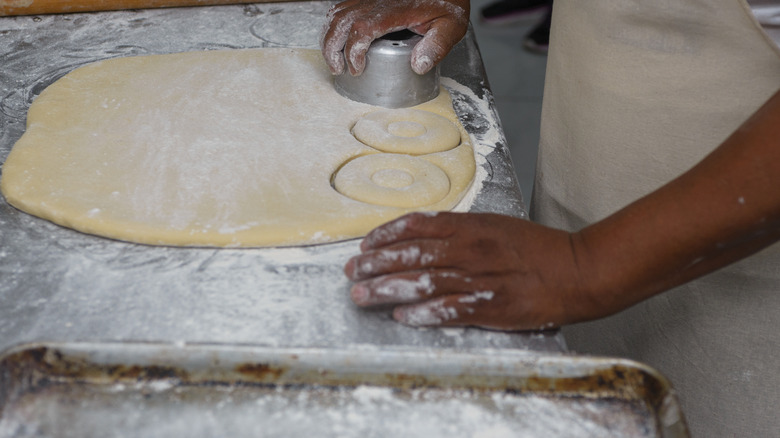
Sandor Mejias B/Shutterstock
Almost every culture around the globe has some kind of traditional fried dough, but the modern donut with a hole in the middle is an American invention. Probably. The legend (as told by the man himself) is that Captain Hanson Gregory, a sailor hailing from Rockport, Maine, was struck with inspiration in 1847. Troubled by the raw dough in the middle of the fried treat, he had an idea. In his words from a 1916 article in The Washington Post (via Food Timeline), "I took the cover off the ship's tin pepper box, and — I cut into the middle of that doughnut the first hole ever seen by mortal eyes!" He showed the idea to his mother, who made several panfuls that were a hit with the locals, and the rest is baking history.
The old-fashioned donut cutter used by home cooks was a metal circle with a smaller metal circle inside it. This tool allowed a baker to easily cut out the main donut shape and the donut hole, keeping every donut and donut hole the same shape and size. A fancier version of the tool was invented by John F. Blondell, also from Maine, in 1872. This version was a spring-loaded tube that automatically pushed the donut hole out. Today, you can buy a donut pan that only requires adding the batter to the donut-shaped mold to make your favorite baked donut recipe.
Cake breaker
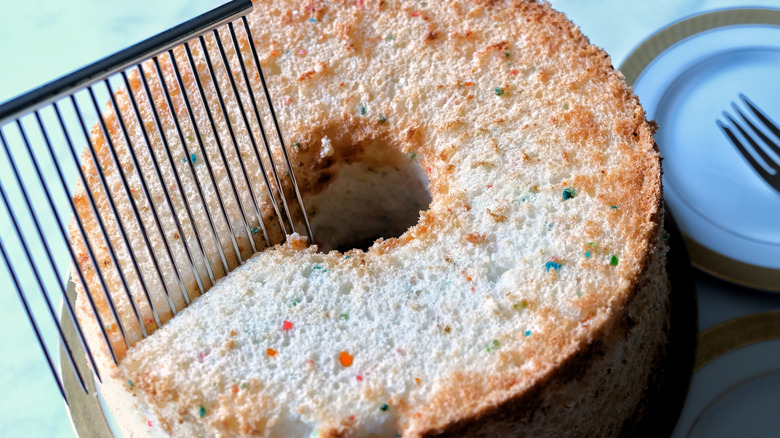
Nancy Salmon/Shutterstock
The perfect angel food cake is light and fluffy, but if you're not careful when you cut into it, you can squish all the fluffiness out of the cake. So in 1932, Cale J. Schneider invented a tool designed to gently slice light and fluffy cakes. The story goes that Schneider created the cake breaker for his wife, who was tired of serving flattened angel food cake to their guests.
The cake breaker tool looks a little like a hand-held rake. It has long, thin prongs that extend from a handle. To use the cake breaker, you simply slide the prongs into the cake and wiggle them back and forth gently to create a break in the cake. You can also use the prongs to easily move the cake to a plate for serving. The cake breaker was also an opportunity to have an aesthetically pleasing kitchen tool to show off. Home bakers could choose intricate silver handles or porcelain handles painted with flowers or bright but simple solid colors.
While you can still find these vintage tools online or in antique stores, the use of cake breakers started to become less popular with the advent of commercial cake mixes and store-bought cakes. These cakes are more reliable and consistent in texture, and don't need as much care in handling. Plus, it was simply more convenient for home bakers to use something like a serrated knife instead of storing and washing an extra single-use tool.
Cookie mold
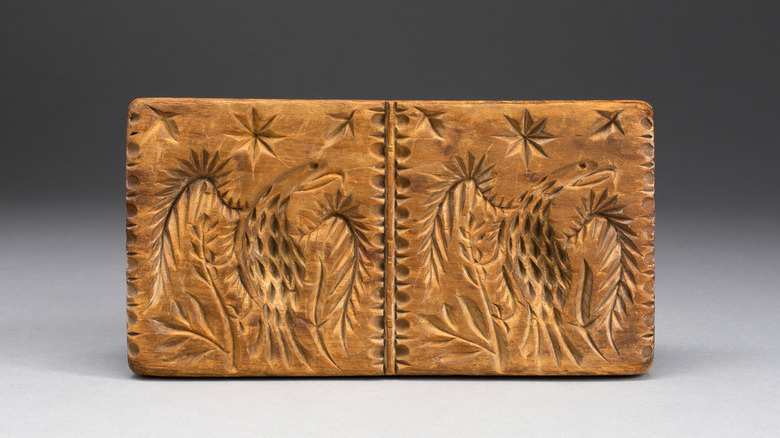
Heritage Images/Getty Images
Before cookie cutters, there were cookie molds. These intricately carved wooden molds were first used in Europe in the 14th century and were primarily utilized for soft butter cookies called springerle. The word "springerle" comes from an old German dialect and means "little knight" or "jumping horse," likely resulting from a pagan holiday tradition of offering animal-shaped bread or cookies as a sacrifice to the gods. The cookie molds were reverse-carved — which means the mold pressed the design into the cookie instead of the cookie filling the mold shape, as with cake molds – a process that worked particularly well with the softer springerle cookies.
Cookie molds weren't just used as decoration. They were also used as a way to tell stories and pass down history. Molded cookies could be used as a kind of picture book, educating people who couldn't read. They were also exchanged during the winter festivities, a little like holiday cards today. In the 18th and 19th centuries, cookie molds were arbiters of pop culture and political propaganda — essentially memes in cookie form. Germans who immigrated to the U.S. brought springerle and cookie molds with them and then passed them down from generation to generation. Today, cookie molds are more cherished heirlooms than everyday baking tools.
Cake tester
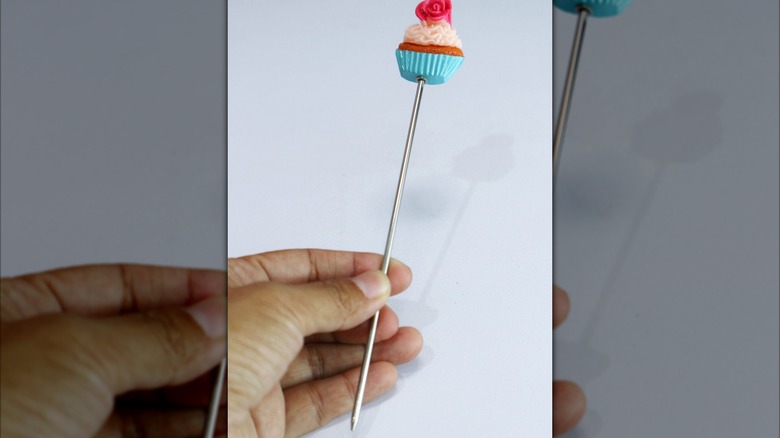
Yellyana/Shutterstock
It doesn't matter what type of cake you're baking — the classic chocolate cake, a stacked red velvet cake, or a traditional birthday sheet cake — you need to know when it's done. Old-school recipes often include the instruction to bake until a cake tester inserted in the center comes out clean. Today, many home bakers automatically reach for a toothpick when they see "cake tester," but did you know that a cake tester is an actual baking tool?
A cake tester is a long, thin stick made out of metal that ends in a sharp point. The top of the cake tester was plastic and might have been something baking-themed and cute, or it might have been a company logo. It was used to test when a cake was fully baked. The cake tester was stuck into the middle of a cake, and if it came out free of any residual batter or crumbs, the cake was done. The metal could also pick up temperature differences across a cake, too. Today, you might find something similar to a cake tester in a kitchen, but it's more likely that it's being used on food other than cake. Some cooks rely on it to test fish or meat in particular. But for cakes, most home bakers reach for the good old toothpick.
Rotary beater
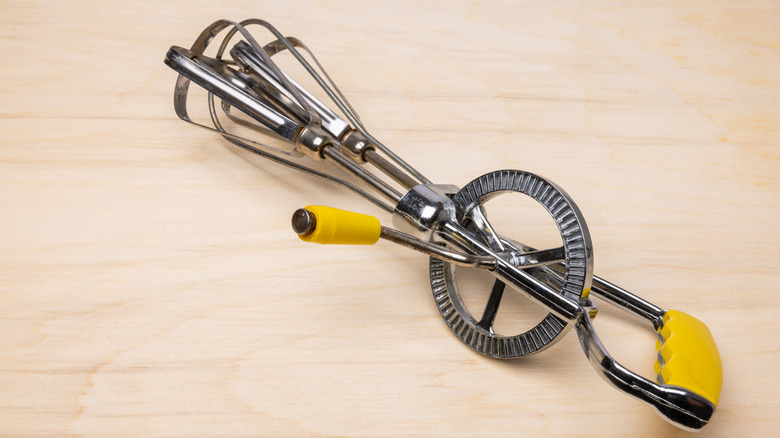
John_brueske/Getty Images
The holy grail of modern home bakers might be an expensive (but effective) KitchenAid stand mixer, with a handheld electric mixer serving as a solid backup appliance. But before the electric mixer came along, one of the biggest upgrades in home cooking happened in the 19th century with the invention of the rotary beater. If you've ever beaten eggs or heavy cream by hand, you know exactly why this invention was such a big deal for home cooks.
Particular baked goods require a lot of air to create the right texture. From cakes and cookies to meringues and whipped cream, certain recipes include a lot of mixing action to properly aerate ingredients. Before the rotary beater was invented, all that action was done manually. Fortunately, in 1884, Willis Johnson patented a mechanical egg beater in Cincinnati, Ohio. While it wasn't the first of its kind, it was designed to save time and effort, and unsurprisingly, home cooks loved it. The rotary beater had a handle at the top for holding the machine steady, and then a handle on the side. When you cranked that handle, it turned a wheel that then spun two connected whisks.
Rotary beaters ruled the kitchen for decades. It wasn't until 1908 that an electric mixer was first invented, and that was designed for commercial use. Home bakers didn't get an electric mixer option until the 1960s, which led to rotary beaters disappearing from kitchens.
Nut grinder
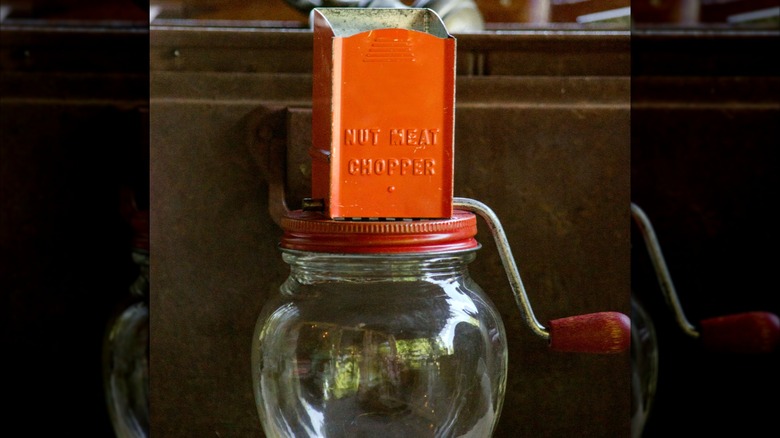
Susan B Sheldon/Shutterstock
Like other old-school baking tools, a nut grinder made baking easier for the home cook. It saved time and effort. Instead of standing over a cutting board, chopping nuts with a knife, a baker would simply drop a handful of nuts into the nut grinder for perfectly chopped nuts every time. A nut grinder was a simple tool. A metal lid was screwed onto the top of a glass jar. On top sat a box, with a hand crank to the side. Turning the crank pushed the whole nuts through a set of rotating metal blades, and then the chopped nuts dropped into the glass container.
This type of nut grinder – also called a nut mill or a nut chopper – was first made in the 1930s and was widely used by home cooks. It was a multipurpose tool, too, grinding spices and breadcrumbs. You might still find vintage nut grinders in antique markets or estate sales, but if you find a modern version, it's probably made of plastic, not glass and metal. Many home cooks now use electric food processors to meet their chopping needs.
Cherry pitter
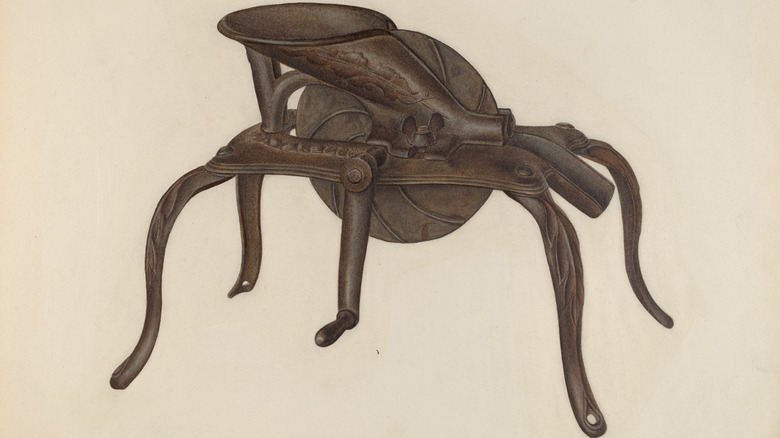
Heritage Images/Getty Images
Before jars and cans of pitted cherries were readily available on grocery store shelves, home bakers had to pit all the cherries they used before baking them into delicious dishes. That might not seem like a big deal for a few cherries, but if you're making a recipe like a cherry clafoutis that calls for a pound of cherries, that's at least 80 cherries you need to pit by hand. Enter the cherry pitter, also called a cherry stoner, a cast iron tool that clamped onto a table or counter to help you process all those cherries.
This heavy chunk of metal had a funnel where you would place a fresh cherry and a handle on the side that, when pressed, would push the cherry through and leave the pit behind. The cherry pitter made it faster and easier to remove pits from the cherry, but the end product wasn't the prettiest. Who invented the first cherry pitter isn't clear, but it was likely first made sometime in the 1800s. Eventually, the tabletop cherry pitters evolved into the hand-held designs used today, where the fruit is held in place and the pit is pushed out, which leaves the cherry more intact.
Cookie press
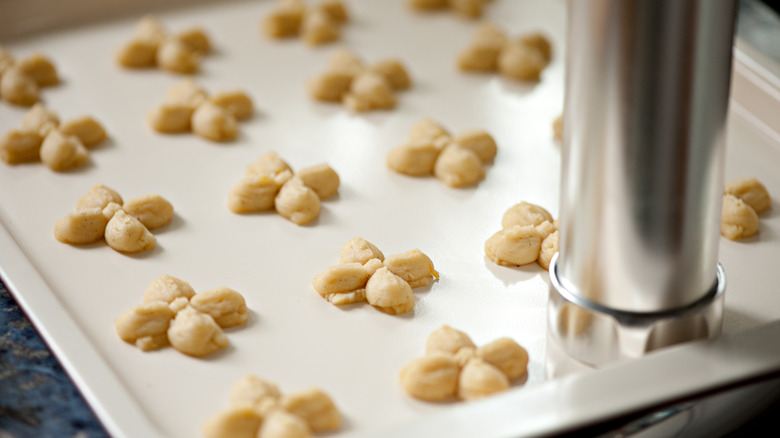
Ralucahotupan/Getty Images
Like the cookie mold, a cookie press is designed to make shaping cookies easier. But unlike the cookie mold, a cookie press can be used to make larger batches of cookies, making it a favorite tool of home chefs in the past. A cookie press, sometimes also called a cookie gun, is a hollow canister you load with cookie dough. There's a trigger to press that squeezes out a set amount of dough. A disk with cutouts sits on the end of the tube. When the dough is pushed out, the disk forces the dough into a consistent shape.
The cookie press was popular in the mid-20th century, as home cooks began prioritizing convenience in the kitchen. The first modern cookie press was made sometime in the 1930s by the Wisconsin-based aluminum cookware company Mirro. Mirro also made the Dial-a-Cookie press, which featured four designs on one disk. This meant home bakers could dial in the design they wanted between each dough press. By the early 1980s, though, Mirro had stopped making their cookie press.
Today, the cookie press isn't a common tool used by home bakers, probably because of its limitations. It really only worked well with softer dough, such as buttery spritz cookies, and not with anything that has added ingredients such as nuts, dried fruit, or chocolate chips. But if you do find a vintage cookie press that you'd like to try, there are a few cookie press tips you should know. For example, the dough shouldn't be too hot or cold, and you should always make sure you're using the right kind of dough ahead of time.
Hand-crank apple peeler
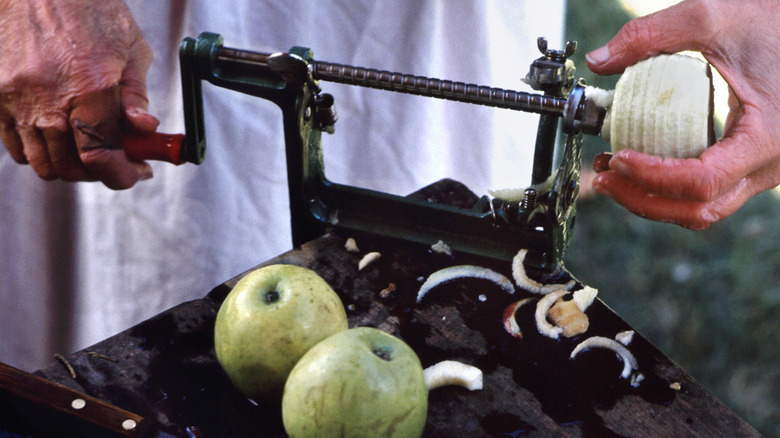
Robert Alexander/Getty Images
Just like pitting cherries, peeling apples isn't necessarily hard. It's just time-consuming if you're making a recipe that calls for a lot of apples. Like vintage cherry pitters, apple peelers were mechanical innovations that revolutionized baking. One sign of how big a deal mechanical apple peelers were to home bakers is the sheer number of patents for apple peelers granted during the 19th and early 20th centuries. Around 250 various mechanical apple peeler designs were patented between 1803 and 1910.
In 1864, one particular type of hand-cranked apple peeler caught people's attention. David Goodell created the lightning apple parer. This not only peeled the apples, but it also sliced and cored them. The whole process took about 10 seconds. When he started demonstrating the machine, home cooks immediately saw how easy it would make their lives, and Goodell sold 24,000 of the device in just three weeks. The Goodell Company, based in Antrim, New Hampshire, made apple peelers (and cherry pitters) for over 100 years. The company closed in 1989.
You can still find old-fashioned metal apple peelers, but the popular versions today tend to be electric, not hand-cranked. There are attachments for your stand mixer and standalone electronic peelers, and they're still time savers in the kitchen.
Pie birds
Pies with a top crust need to be vented in some way. Otherwise, the pie filling may bubble up and leak out through weak spots in the crust. In Victorian-era Great Britain, bakers would place a small cylinder made of ceramic in the center of the pie before baking. That tool helped keep the pie crust crispy by letting steam out. In the 1930s, though, ceramics makers started having a little fun with the shape, turning them into little birds.
The first official pie bird in the U.S. was made in Ohio in the 1920s by the Pearl China Company. In her book "Four & Twenty Blackbirds, Vol. 1: Pie Birds, A Pictorial Identification and Value Guide," Linda Fields noted that the first American-made pie bird was a rooster (via Post Bulletin). The pie bird was placed on the bottom crust, the filling was added around it, and then the top pie crust was cut to allow the top of the bird to peek through.
It's possible that the whimsical bird shape came from the nursery rhyme "Sing a Song of Sixpence," which references blackbirds baked in a pie. The finished pie looks like a bird bursting into song from the center of the pie, as is described in the nursery rhyme." Today, this quirky, old-fashioned tool is more of a collector's item than an everyday baking must-have, but if you find one, it's a fun way to serve your homemade pie.



